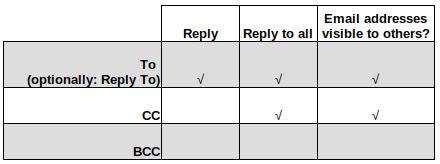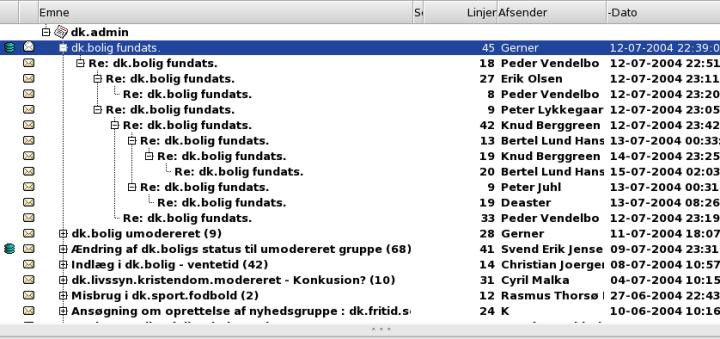
In my line of work I spend a big part of my day sending and receiving emails. It has been shocking to me how many people do not know how to properly use email’s parameters, i.e. CC, BCC and Reply to, as well as when to do a Reply or Reply to all. A too familiar example is an email with tens of addresses as recipients of the message, followed by a torrent of “thank yous”, “really appreciate it”, etc. landing in your inbox.
In this post I am trying to clarify the concepts and practices of emailing in the hope that I might save some inbox congestion for some people, and some carbon dioxide from the planet’s atmosphere. The following table summarises who receives an email according to how we reply to it.
Table 1: Columns: where the email addresses are | Rows: how the user replies to the email
What this table tells us is that when you Reply to an email, the message is delivered to the initial sender, plus all the emails that have been added as To (recipients). Alternatively, if the initial composer of the mail has set a Reply to address, the message will be delivered to that email (not to the composer’s personal email) plus to all the emails designated as To.
When you Reply to all, the message will be delivered to all of the above plus all the email addresses designated as CC (carbon copy).
Email addresses in BCC (blind carbon copy) will not receive any reply and will not be visible to anyone.
Think before hitting “send”
Let’s think about the implications of our actions for a moment. Adding an email address as a To or CC will make it visible to all the recipients. Don’t do this if you don’t have the consent of the person behind that email address. If they need to have knowledge of this specific email, but they are not required to participate in the conversation, add them as BCC.
Going back to the “thank you” replies that we used as an example in the beginning of this post: expressing gratitude in public is a social norm that is dictated by a certain social etiquette and as such it is used as an ethical reward and, thus, as an adhesive substance of our communities. But in the online space it does not work like this. What is beneficial in AFK (away-from-keyboard) life can rather work adversely in our mailbox. Just imagine being regularly spammed by tens of thank you emails while trying to deal with your daily business correspondence. At some point it becomes unmanageable. So be wise when responding to all. If you want to express your gratitude, explain why it is important to you. This might add something valuable for the rest of the recipients as well, making it worth the while to receive and read through your email.
Mind the threads
An additional implication of how we structure communication via email is the formulation of the threading. See the following Image for example.
Email threading. The way recipients reply to an email creates the thread.
Here we can see a step-thread, where each reply follows the latest email that has been sent in the given conversation. This usually ends up in a “bottomless” down-slope thread, where context is usually lost. Compare the above image to the one that follows.
A more context-respecting email threading
In the above, the email threading is more context-sensitive: the replies follow the relevant email, and not necessarily the last email received. It is a much more structured thread, that can act as an ally for when you want to search and retrieve information. So think before you hit the Reply button: is this the person I want to reply to?
Caring for the environment
A last thing to consider (at least for this post) is environmental sustainability. When sending an attachment to many recipients the file travels through the wires across half the world. [1] It might not seem like much, but some estimates reveal that sending an attachment to many may produce as much as 50gr of CO2 emissions just for a single email! (This is the equivalent of five plastic bags in terms of CO2 emissions.) A much better practice, in terms of environmental sustainability, would be to upload the file in an online storage [2] and share the link to that file instead.
Now you know
To sum it up, I hope that I managed to make obvious that you need to make some choices and think wisely before sending an email. And now you have the information you need, in order to choose wisely. Think not only about who needs to receive the message, but also how you expect the conversation to evolve. Be aware of other people’s precious attention and try to add value to every one of your communications. Do not forget the environmental impact of your online activity and try to avoid circulating massive attachments.
If all this makes sense to you go ahead and leverage that network effect: Share it with your peers!
[1] The other half do not have internet access yet!
[2] You can use a self-hosted solution such as Nextcloud to host your files online, ensuring that you don’t share your data with third party services and vendors. Many hosting solutions offer single-click deployment of Nextcloud for a very small amount per year.
Vassilis Chryssos is the grants coordinator and executive assistant at APC. This post originally appeared on his own blog. He also created the illustration for this piece.


